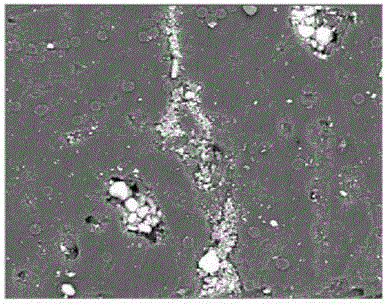Method for modifying C/C composite material at low temperature by microwave-ultrasonic-ultraviolet process
A technology of composite materials and carbon composite materials, which is applied in the field of microwave-ultrasonic-ultraviolet low-temperature modification of C/C composite materials, which can solve protection failure, volatile compounds, and degradation of mechanical and thermal properties of C/C composite materials, etc. problem, to achieve the effect of improved antioxidant performance, improved antioxidant performance, and low raw material prices
- Summary
- Abstract
- Description
- Claims
- Application Information
AI Technical Summary
Problems solved by technology
Method used
Image
Examples
Embodiment 1
[0021] 1) Take the 2D-carbon / carbon composite material used in aircraft brake pads and process it into 10×10×3mm 3 The small cubes were polished and chamfered on the surface, then cleaned with absolute ethanol and deionized water in an ultrasonic generator, and dried in an oven for later use;
[0022] 2) Mix analytically pure tri-n-butyl borate and absolute ethanol at a volume ratio of 1:2, and keep stirring, which is recorded as A;
[0023] 3) Mix A with analytically pure acetic acid at a volume ratio of 2:1, and keep stirring to form a sol precursor, which is denoted as B;
[0024] 4) Then add 10% of the mass of B to B ZrB 2 Powder, stirred to form a uniform suspension C;
[0025] 5) Pour the suspension C into a four-neck round bottom flask, and place the 2D-carbon / carbon composite material in the suspension C. Put the equipped four-neck round bottom flask into a UWave-1000 microwave, ultraviolet, and ultrasonic The trinity synthesis extraction reaction instrument is fixe...
Embodiment 2
[0028] 1) Take the 2D-carbon / carbon composite material used in aircraft brake pads and process it into 10×10×3mm 3 The small cubes were polished and chamfered on the surface, then cleaned with absolute ethanol and deionized water in an ultrasonic generator, and dried in an oven for later use;
[0029] 2) Mix the analytically pure tri-n-butyl borate and absolute ethanol at a volume ratio of 1:3, and keep stirring, and record it as A;
[0030] 3) Mix A with analytically pure acetic acid at a volume ratio of 3:1 and keep stirring to form a sol precursor, which is denoted as B;
[0031] 4) Then add 10% of the mass of B to B ZrB 2 Powder, stirred to form a uniform suspension C;
[0032] 5) Pour the suspension C into a four-neck round bottom flask, and place the 2D-carbon / carbon composite material in the suspension C. Put the equipped four-neck round bottom flask into a UWave-1000 microwave, ultraviolet, and ultrasonic The trinity synthesis extraction reaction instrument is fixed...
Embodiment 3
[0035] 1) Take the 2D-carbon / carbon composite material used in aircraft brake pads and process it into 10×10×3mm 3The small cubes were polished and chamfered on the surface, then cleaned with absolute ethanol and deionized water in an ultrasonic generator, and dried in an oven for later use;
[0036] 2) Mix the analytically pure tri-n-butyl borate and absolute ethanol at a volume ratio of 1:4, and keep stirring, and record it as A;
[0037] 3) Mix A with analytically pure acetic acid at a volume ratio of 2.5:1 and keep stirring to form a sol precursor, which is denoted as B;
[0038] 4) Then add 10% of the mass of B to B ZrB 2 Powder, stirred to form a uniform suspension C;
[0039] 5) Pour the suspension C into a four-neck round bottom flask, and place the 2D-carbon / carbon composite material in the suspension C. Put the equipped four-neck round bottom flask into a UWave-1000 microwave, ultraviolet, and ultrasonic The trinity synthesis extraction reaction instrument is fixe...
PUM
 Login to View More
Login to View More Abstract
Description
Claims
Application Information
 Login to View More
Login to View More - R&D
- Intellectual Property
- Life Sciences
- Materials
- Tech Scout
- Unparalleled Data Quality
- Higher Quality Content
- 60% Fewer Hallucinations
Browse by: Latest US Patents, China's latest patents, Technical Efficacy Thesaurus, Application Domain, Technology Topic, Popular Technical Reports.
© 2025 PatSnap. All rights reserved.Legal|Privacy policy|Modern Slavery Act Transparency Statement|Sitemap|About US| Contact US: help@patsnap.com


